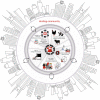Catch-22: War, Refugees, COVID-19, and the Scourge of Antimicrobial Resistance
- PMID: 35814789
- PMCID: PMC9263824
- DOI: 10.3389/fmed.2022.921921
Catch-22: War, Refugees, COVID-19, and the Scourge of Antimicrobial Resistance
Abstract
Wars have hidden repercussions beyond the immediate losses of life, well-being, and prosperity. Those that flee wars and seek refuge in safer locations are not immune to the tragic impacts. Of particular concern is the susceptibility of the refugee populations to infectious diseases and antimicrobial-resistant pathogens. This poses a detrimental risk to these disenfranchised populations, who often have limited access to medical care, sanitation, and nutritious and safe food. Furthermore, antimicrobial-resistant pathogens in refugees can be both transmitted to and acquired from their hosting communities. The latter is particularly problematic when the host countries suffer from serious challenges such as limited resources, pollution, and widespread antimicrobial resistance (AMR). Here, we discuss AMR in refugees of the ongoing Syrian war, a conflict that resulted in the largest population displacement in recent history. We argue that Syrian refugees and their hosting communities are at an elevated risk of complicated and life-threatening AMR infections. We also call on the international community to address this grievous problem that threatens the disenfranchised refugee populations and can spill over across geographic borders to affect multiple countries.
Keywords: COVID-19; antimicrobial resistance; armed conflict; civil war; displaced populations; infectious diseases; one health; refugees.
Copyright © 2022 Osman, Cummings, El Omari and Kassem.
Conflict of interest statement
The authors declare that the research was conducted in the absence of any commercial or financial relationships that could be construed as a potential conflict of interest.
Figures


Similar articles
-
A summary and appraisal of existing evidence of antimicrobial resistance in the Syrian conflict.Int J Infect Dis. 2018 Oct;75:26-33. doi: 10.1016/j.ijid.2018.06.010. Epub 2018 Jun 21. Int J Infect Dis. 2018. PMID: 29936319 Review.
-
Antimicrobial resistance in the protracted Syrian conflict: halting a war in the war.Future Microbiol. 2021 Jul;16:825-845. doi: 10.2217/fmb-2021-0040. Epub 2021 Jul 5. Future Microbiol. 2021. PMID: 34223789
-
Famine-affected, refugee, and displaced populations: recommendations for public health issues.MMWR Recomm Rep. 1992 Jul 24;41(RR-13):1-76. MMWR Recomm Rep. 1992. PMID: 1326713
-
Healthcare Service Access and Utilization among Syrian Refugees in Turkey.Ann Glob Health. 2019 Mar 20;85(1):42. doi: 10.5334/aogh.2353. Ann Glob Health. 2019. PMID: 30896133 Free PMC article.
-
Antimicrobial resistance and the current refugee crisis.J Glob Antimicrob Resist. 2017 Sep;10:75-79. doi: 10.1016/j.jgar.2017.03.013. Epub 2017 Jul 1. J Glob Antimicrob Resist. 2017. PMID: 28673700 Review.
Cited by
-
Antifungal Use and Resistance in a Lower-Middle-Income Country: The Case of Lebanon.Antibiotics (Basel). 2023 Sep 6;12(9):1413. doi: 10.3390/antibiotics12091413. Antibiotics (Basel). 2023. PMID: 37760710 Free PMC article.
-
Editorial: World antimicrobial awareness week.Front Public Health. 2025 Jan 7;12:1543642. doi: 10.3389/fpubh.2024.1543642. eCollection 2024. Front Public Health. 2025. PMID: 39839430 Free PMC article. No abstract available.
-
Prepared for the polycrisis? The need for complexity science and systems thinking to address global and national evidence gaps.BMJ Glob Health. 2024 Sep 11;9(9):e014887. doi: 10.1136/bmjgh-2023-014887. BMJ Glob Health. 2024. PMID: 39266018 Free PMC article. Review.
-
Zoonotic Tuberculosis: A Neglected Disease in the Middle East and North Africa (MENA) Region.Diseases. 2023 Mar 1;11(1):39. doi: 10.3390/diseases11010039. Diseases. 2023. PMID: 36975589 Free PMC article. Review.
-
Prevalence and Molecular Mechanisms of Carbapenem Resistance among Gram-Negative Bacilli in Three Hospitals of Northern Lebanon.Antibiotics (Basel). 2022 Sep 22;11(10):1295. doi: 10.3390/antibiotics11101295. Antibiotics (Basel). 2022. PMID: 36289953 Free PMC article.
References
LinkOut - more resources
Full Text Sources
Miscellaneous

